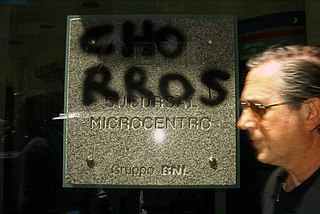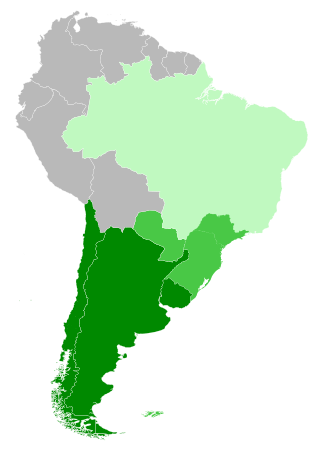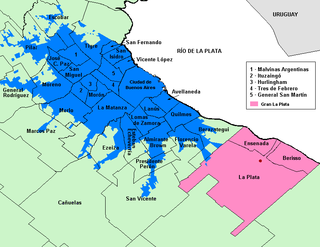Related Research Articles

Lunfardo is an argot originated and developed in the late 19th and early 20th centuries in the lower classes in Buenos Aires and from there spread to other urban areas nearby, such as the Greater Buenos Aires, Rosario and Montevideo.

The Southern Cone is a geographical and cultural subregion composed of the southernmost areas of South America, mostly south of the Tropic of Capricorn. Traditionally, it covers Argentina, Chile, and Uruguay, bounded on the west by the Pacific Ocean and on the east by the Atlantic Ocean. In terms of social, economic and political geography, the Southern Cone comprises Argentina, Chile, and Uruguay, and sometimes includes Brazil's four southernmost states. In its broadest definition, taking into account common history and geography, it also includes Paraguay, another Spanish-speaking country.

The culture of Argentina is as varied as the country's geography and is composed of a mix of ethnic groups. Modern Argentinian culture has been influenced largely by Italian, Spanish, and other European immigration, while there is still a lesser degree of elements of the Amerindians of Argentina, particularly in the fields of music and art. Buenos Aires, its cultural capital, is largely characterized by both the prevalence of people of Southern European descent, and of European styles in architecture. Museums, cinemas, and galleries are abundant in all of the large urban centers, as well as traditional establishments such as literary bars, or bars offering live music of a variety of music genres.

A Spanish creole, or Spanish-based creole language, is a creole language for which Spanish serves as its substantial lexifier.
Vesre is one of the features of Rioplatense Spanish slang. Natives of Argentina and Uruguay use vesre sparingly in colloquial speaking, and rarely in formal circumstances. Tango lyrics make widespread use of lunfardo and vesre to highlight the intended underworld atmosphere, or for comic relief.

Cocoliche is an Italian–Spanish contact language or pidgin that was spoken by Italian immigrants in Argentina and Uruguay between 1870 and 1970. In the last decades of the 20th century, it almost completely disappeared, with its vestiges being found in Lunfardo, which in itself was an influence to the Rioplatense Spanish variety.

Rioplatense Spanish, also known as Rioplatense Castilian, is a variety of Spanish spoken mainly in and around the Río de la Plata Basin of Argentina and Uruguay. It is also referred to as River Plate Spanish or Argentine Spanish. It is the most prominent dialect to employ voseo in both speech and writing. Many features of Rioplatense are also shared with the varieties spoken in south and eastern Bolivia, and Paraguay. This dialect is often spoken with an intonation resembling that of the Neapolitan language of Southern Italy, but there are exceptions.

Immigration to Argentina began in several millennia BCE with the arrival of different populations from Asia to the Americas through Beringia, according to the most accepted theories, and were slowly populating the Americas. Upon arrival of the Spaniards, the native inhabitants of Argentine territory were approximately 300,000 people belonging to many Indigenous American civilizations, cultures, and tribes.

Chilean Spanish is any of several varieties of the Spanish language spoken in most of Chile. Chilean Spanish dialects have distinctive pronunciation, grammar, vocabulary, and slang usages that differ from those of Standard Spanish. Formal Spanish in Chile has recently incorporated an increasing number of colloquial elements.

Fray Mocho was the pen name for the Argentine writer and journalist José Ciriaco Alvarez. He moved to Buenos Aires first in 1876 and then again to stay in 1879 at the age of 21. He was known to his friends as "Mocho" (blunt) and later added the title "Fray". He wrote for several newspapers including El Nacional, La Pampa, La Patria Argentina, and La Razón. He also wrote for magazines such as the short-lived Fray Gerundio, El Ateneo and La Colmena Artística. He wrote essays about life in Buenos Aires in the latter part of the 19th century, including Esmeraldas (polished), Cuentos Mundanos, La vida de los ladrones célebres de Buenos Aires y sus maneras de robar and Memorias de un Vigilante. In 1898 he wrote the book En el Mar Austral.

Spanish is the language that is predominantly understood and spoken as a first, or second language by nearly all of the population of Argentina. According to the latest estimations, the population is currently greater than 45 million.

The Italian language in Venezuela has been present since colonial times in the areas around Caracas, Maracay, Valencia, Maracaibo and the Andes mountains. The language is found in many idiomatic sentences and words of Venezuelan Spanish. There are around 200,000 Italian-speakers in the country, turning it in the second most spoken language in Venezuela, after Spanish.

Foreign relations between Argentina and France, have existed nearly a century. Both states are members of the G-20.

Italian Argentines are Italian-born people or non-Italian citizens of Italian descent residing in Argentina. Italian is the largest single ethnic origin of modern Argentines. In 2011, it was estimated that at least 25 million Argentines have some degree of Italian ancestry. Argentina has the second-largest community of Italians outside of Italy, after Brazil.

French Argentines refers to Argentine citizens of full or partial French ancestry or persons born in France who reside in Argentina. French Argentines form one of the largest ancestry groups after Italian Argentines and Spanish Argentines. Between 1857 and 1946, 261,020 French people immigrated to Argentina. Besides immigration from continental France, Argentina also received, as early as the 1840s, immigrants with French background from neighboring countries, notably Uruguay, which expanded the French Argentine community. In 2006, it was estimated that around 6 million Argentines had some degree of French ancestry, up to 17% of the total population.

Paraguayan Spanish is the set of dialects of the Spanish language spoken in Paraguay. In addition, it influences the speech of the Argentine provinces of Misiones, Corrientes, Formosa, and, to a lesser extent, Chaco. Paraguayan Spanish possesses marked characteristics of Spanish previously spoken in northern Spain, because the majority of the first settlers were from Old Castile and the Basque Country.
Uruguayan Spanish is the variety of Spanish spoken in Uruguay and by the Uruguayan diaspora. Uruguayan Spanish is recognized as a variety of Rioplatense Spanish.
Nardo Zalko was an Argentinian-French journalist, author, researcher, and historian of tango.
References
- "Breve diccionario etimológico de la lengua española" by Guido Gómez de Silva ( ISBN 968-16-2812-8)